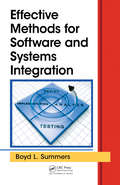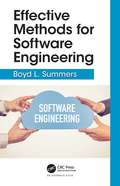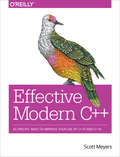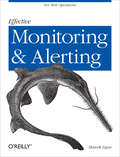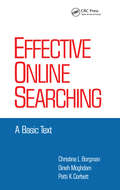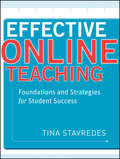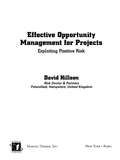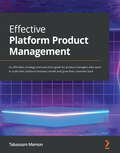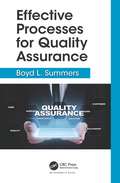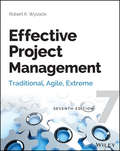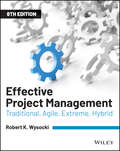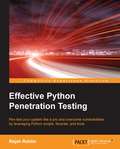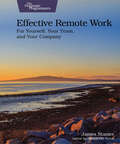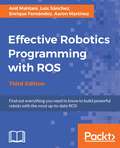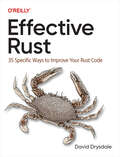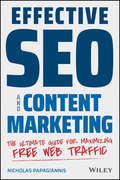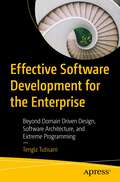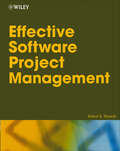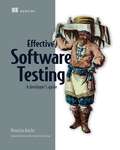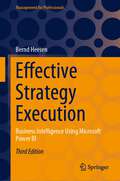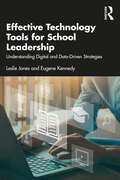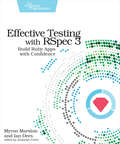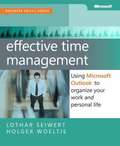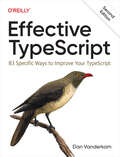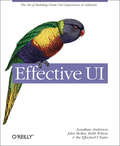- Table View
- List View
Effective Methods for Software and Systems Integration
by Boyd L. SummersBefore software engineering builds and installations can be implemented into software and/or systems integrations in military and aerospace programs, a comprehensive understanding of the software development life cycle is required. Covering all the development life cycle disciplines, Effective Methods for Software and Systems Integration explains h
Effective Methods for Software Engineering
by Boyd L. SummersSoftware is important because it is used by a great many people in companies and institutions. This book presents engineering methods for designing and building software. Based on the author’s experience in software engineering as a programmer in the defense and aerospace industries, this book explains how to ensure a software that is programmed operates according to its requirements. It also shows how to develop, operate, and maintain software engineering capabilities by instilling an engineering discipline to support programming, design, builds, and delivery to customers. This book helps software engineers to: Understand the basic concepts, standards, and requirements of software engineering. Select the appropriate programming and design techniques. Effectively use software engineering tools and applications. Create specifications to comply with the software standards and requirements. Utilize various methods and techniques to identify defects. Manage changes to standards and requirements. Besides providing a technical view, this book discusses the moral and ethical responsibility of software engineers to ensure that the software they design and program does not cause serious problems. Software engineers tend to be concerned with the technical elegance of their software products and tools, whereas customers tend to be concerned only with whether a software product meets their needs and is easy and ready to use. This book looks at these two sides of software development and the challenges they present for software engineering. A critical understanding of software engineering empowers developers to choose the right methods for achieving effective results. Effective Methods for Software Engineering guides software programmers and developers to develop this critical understanding that is so crucial in today’s software-dependent society.
Effective Modern C++: 42 Specific Ways to Improve Your Use of C++11 and C++14
by Scott MeyersComing to grips with C++11 and C++14 is more than a matter of familiarizing yourself with the features they introduce (e.g., auto type declarations, move semantics, lambda expressions, and concurrency support). The challenge is learning to use those features effectively--so that your software is correct, efficient, maintainable, and portable. That's where this practical book comes in. It describes how to write truly great software using C++11 and C++14--i.e. using modern C++.Topics include:The pros and cons of braced initialization, noexcept specifications, perfect forwarding, and smart pointer make functionsThe relationships among std::move, std::forward, rvalue references, and universal referencesTechniques for writing clear, correct, effective lambda expressionsHow std::atomic differs from volatile, how each should be used, and how they relate to C++'s concurrency APIHow best practices in "old" C++ programming (i.e., C++98) require revision for software development in modern C++Effective Modern C++ follows the proven guideline-based, example-driven format of Scott Meyers' earlier books, but covers entirely new material.
Effective Monitoring and Alerting
by Slawek LigusWith this practical book, you'll discover how to catch complications in your distributed system before they develop into costly problems. Based on his extensive experience in systems ops at large technology companies, author Slawek Ligus describes an effective data-driven approach for monitoring and alerting that enables you to maintain high availability and deliver a high quality of service. Learn methods for measuring state changes and data flow in your system, and set up alerts to help you recover quickly from problems when they do arise. If you're a system operator waging the daily battle to provide the best performance at the lowest cost, this book is for you. Monitor every component of your application stack, from the network to user experience Learn how to draw the right conclusions from the metrics you obtain Develop a robust alerting system that can identify problematic anomalies--without raising false alarms Address system failures by their impact on resource utilization and user experience Plan an alerting configuration that scales with your expanding network Learn how to choose appropriate maintenance times automatically Develop a work environment that fosters flexibility and adaptability
Effective Online Searching: A Basic Text
by Christine L. Borgman Dineh Moghdam Patti K. CorbettThis book focuses on searching and hands-on experience, which makes the text suitable for those who wish to learn searching for their own use as well. It is intended for those who will act as search intermediaries, accepting questions from clients and performing the searches.
Effective Online Teaching
by Tina StavredesIn order to enable the widespread adoption of online education, faculty must be trained in the pedagogy of teaching in this medium. This book offers an understanding of how cognition and learning theory applies to an online learning environment. Through behaviorist, constructivist, and cognitive approaches it provides strategies for incorporating this knowledge into effective learner-centered teaching practice. Each chapter contains reflection and discussion questions which can be used for self-directed learning. It is ideal for new instructors or those new to online teaching.
Effective Opportunity Management for Projects: Exploiting Positive Risk (Pm Solutions Research Ser. #Vol. 6)
by David HillsonWith step-by-step guidelines, this bestselling reference discusses the management of project opportunities by expanding the traditional risk management process to address opportunities alongside threats. It offers valuable tools and techniques that expose and capture opportunities, minimize threats, and deal with all types of uncertainty in your business and projects. Written by an experienced consultant and risk management specialist, this guide emphasizes that risk processes must cover both opportunities and threats if they are to assist in accomplishing project objectives and maximizing business benefits.
Effective Platform Product Management: A product manager's guide to strategizing and executing the platform business model to expand the customer base
by Tabassum MemonDesign, strategize, and implement a proven roadmap for your platforms to scale your business across multiple channels that provide a seamless and intuitive user experienceKey FeaturesUnderstand the importance of platform business models and the difference between linear products and platformsExplore the end-to-end platform life cycle, from developing a strategy to measuring the outcomeDiscover the benefits of the platform business model and effective strategies through examplesBook DescriptionIn recent years, platform business models have revolutionized various industries, including retail and media. Companies such as Amazon, Netflix, and Spotify have changed how businesses reach out to their consumers. With the rise of these platforms and the increased use of technology, consumers prefer to search, explore, compare, and choose between different options within a single uninterrupted user experience. Providing such an experience is difficult and almost impossible when using linear models, and this is why modern businesses must adopt a platform-first approach to change how they invent, develop, and market solutions. This book addresses a critical pillar of platform development – product management. It'll help you to understand the difference between traditional and modern product management for platforms while exploring the importance and benefits of the platform business model. As you progress, you'll be able to build the right platform strategy, define the MVP, and focus on ongoing backlog prioritization for successful platforms. This book also walks you through the steps and guidelines that'll help organizations and product managers to transition from linear products to platforms. By the end of this platform product management book, you'll have learned the essential aspects of product management for building successful and scalable platforms.What you will learnUnderstand the difference between the product and platform business modelBuild an end-to-end platform strategy from scratchTranslate the platform strategy to a roadmap with a well-defined implementation planDefine the MVP for faster releases and test viability in the early stagesCreate an operating model and design an execution planMeasure the success or failure of the platform and make iterations after feedbackWho this book is forThis book is for product managers, product owners, product directors, and business executives responsible for defining platform strategy and its day-to-day execution. The book will also be useful for change managers and program managers who are responsible for the transition from products to platforms. No prior knowledge of platform strategy or platform transitioning is required as the book covers these topics to help you get started.
Effective Processes for Quality Assurance
by Boyd L. SummersDriving innovation can reduce costs for companies, institutions, military programs, and successful businesses. Quality is key to successful innovation. Delivery of complex products must have high quality to reduce customer problems and defects. This book explains how to integrate Quality Assurance processes to produce compliant product management and gap analysis. It shows how Quality Assurance provides a common operating framework in which best practices, improvements, and cost avoidance activities can be shared. Effective Processes for Quality Assurance emphasizes improving process execution and reducing operational costs. It also focuses on how Quality Assurance personnel must support companies, institutions, military programs, and successful businesses by encouraging a cooperative, proactive approach and ensure compliance through management and team member participation. Lean and Agile can provide a competitive advantage, and this practical reference explains how to implement these two principles to deliver products that have fewer defects. It also explains: Quality Assurance methods Measuring benefits of Quality Assurance process improvement Quality Assurance performance and improvement Risk management Quality Assurance improvement with metrics Effective processes for Quality Assurance Quantitative process performance and commitments Quality Assurance plans Quality Assurance for customers and suppliers Supporting software configuration Effective Processes for Quality Assurance covers the critical issues for implementing Quality Assurance processes that can deliver high-quality products successfully.
Effective Project Management
by Robert K. WysockiUnlock your potential and achieve breakthrough performance in project managementIf you're looking for a more robust approach to project management--one that recognizes the project environment and adapts accordingly--then this is the perfect resource. It not only guides you through the traditional methods, but also covers the adaptive and extreme approaches as well. You'll gain an in-depth understanding of each one and know exactly when and how to use them.You'll also be introduced to the Adaptive Project Framework, which arms you with a new project management methodology. And with the help of two new case studies, you'll be able to put these ideas into practice and experience some of the contemporary nuances of projects.This definitive guide to project management shows you how to:Take advantage of new variations on traditional project management methods, including risk assessment and controlDecide the best method for managing specific types of projects by analyzing all of the pros and consApply the Adaptive Project Framework to the world of fast-paced, high-change, and complex projectsCreate a war room to successfully manage multiple team projectsDetermine how project portfolio management approaches can help companies achieve a greater return on investmentUtilize all nine Project Management Body of Knowledge (PMBOK) standards advocated by the Project Management Institute (PMI)
Effective Project Management: Traditional, Agile, Extreme, Hybrid
by Robert K. WysockiThe popular guide to the project management body of knowledge, now fully updated Now in its seventh edition, this comprehensive guide to project management has long been considered the standard for both professionals and academics, with nearly 40,000 copies sold in the last three editions! Well-known expert Robert Wysocki has added four chapters of new content based on instructor feedback, enhancing the coverage of best-of-breed methods and tools for ensuring project management success. With enriched case studies, accompanying exercises and solutions on the companion website, and PowerPoint slides for all figures and tables, the book is ideal for instructors and students as well as active project managers. Serves as a comprehensive guide to project management for both educators and project management professionals Updated to cover the new PMBOK® Sixth Edition Examines traditional, agile, and extreme project management techniques; the Enterprise Project Management Model; and Kanban and Scrumban methodologies Includes a companion website with exercises and solutions and well as PowerPoint slides for all the figures and tables used Written by well-known project management expert Robert Wysocki Effective Project Management, Eighth Edition remains the comprehensive resource for project management practitioners, instructors, and students.(PMBOK is a registered mark of the Project Management Institute, Inc.)
Effective Python Penetration Testing
by Rejah RehimPen test your system like a pro and overcome vulnerabilities by leveraging Python scripts, libraries, and tools About This Book * Learn to utilize your Python scripting skills to pentest a computer system, network, and web-application * Get proficient at the art of assessing vulnerabilities by conducting effective penetration testing * This is the ultimate guide that teaches you how to use Python to protect your systems against sophisticated cyber attacks Who This Book Is For This book is ideal for those who are comfortable with Python or a similar language and need no help with basic programming concepts, but want to understand the basics of penetration testing and the problems pentesters face. What You Will Learn * Write Scapy scripts to investigate network traffic * Get to know application fingerprinting techniques with Python * Understand the attack scripting techniques * Write fuzzing tools with pentesting requirements * Learn basic attack scripting methods * Utilize cryptographic toolkits in Python * Automate pentesting with Python tools and libraries In Detail Penetration testing is a practice of testing a computer system, network, or web application to find weaknesses in security that an attacker can exploit. Effective Python Penetration Testing will help you utilize your Python scripting skills to safeguard your networks from cyberattacks. We will begin by providing you with an overview of Python scripting and penetration testing. You will learn to analyze network traffic by writing Scapy scripts and will see how to fingerprint web applications with Python libraries such as ProxMon and Spynner. Moving on, you will find out how to write basic attack scripts, and will develop debugging and reverse engineering skills with Python libraries. Toward the end of the book, you will discover how to utilize cryptography toolkits in Python and how to automate Python tools and libraries. Style and approach This is an expert's guide to Python with a practical based approach, where each chapter will help you improve your penetration testing skills using Python to become a master pen tester.
Effective Remote Work: For Yourself, Your Team, And Your Company
by Dr James StanierThe office isn't as essential as it used to be. Flexible working hours and distributed teams are replacing decades of on-site, open-plan office culture. Wherever you work from nowadays, your colleagues are likely to be somewhere else. No more whiteboards. No more water coolers. And certainly no Ping-Pong. So how can you organize yourself, ship software, communicate, and be impactful as part of a globally distributed workforce? We'll show you how. It's time to adopt a brand new mindset. Remote working is here to stay. Come and join us. Remote working is on the rise. Whether or not we are remote workers, it is likely we are all part of a global workforce. We need to learn to interact remotely, because we are all remote from someone in some way. Rather than simply simulating the way we'd usually work together via digital means, we have to learn new communication skills and adopt a different mindset in order to work remotely effectively, efficiently, and, most importantly, healthily.We'll start by getting you set up with the right equipment and habits. Then, we'll learn the mindset of treating everyone as remote, and conquer both synchronous and asynchronous communication. You'll learn how to produce amazing artifacts, how to communicate clearly, and how to manage yourself and your teams. Then we'll look at the bigger picture: from measuring the remote readiness of your workplace, to creating a handbook for your team, to exploring remote-first culture and tackling burnout and mental well-being.Fundamentally we'll see that adopting a remote-working mindset can do wonders for our organization, our effectiveness, and our impact in our careers. It can even create a more diverse and inclusive industry for us all to work in.So what are you waiting for? The remote future is now. Be a part of it.What You Need:There are no prerequisites to reading this book, other than having had some experience of working in the software industry and a healthy curiosity.
Effective Robotics Programming with ROS - Third Edition
by Luis Sanchez Enrique Fernandez Anil Mahtani Aaron MartinezFind out everything you need to know to build powerful robots with the most up-to-date ROS About This Book • This comprehensive, yet easy-to-follow guide will help you find your way through the ROS framework • Successfully design and simulate your 3D robot model and use powerful robotics algorithms and tools to program and set up your robots with an unparalleled experience by using the exciting new features from Robot Kinetic • Use the latest version of gazebo simulator, OpenCV 3.0, and C++11 standard for your own algorithms Who This Book Is For This book is suitable for an ROS beginner as well as an experienced ROS roboticist or ROS user or developer who is curious to learn ROS Kinetic and its features to make an autonomous Robot. The book is also suitable for those who want to integrate sensors and embedded systems with other software and tools using ROS as a framework. What You Will Learn • Understand the concepts of ROS, the command-line tools, visualization GUIs, and how to debug ROS • Connect robot sensors and actuators to ROS • Obtain and analyze data from cameras and 3D sensors • Use Gazebo for robot/sensor and environment simulation • Design a robot and see how to make it map the environment, navigate autonomously, and manipulate objects in the environment using MoveIt! • Add vision capabilities to the robot using OpenCV 3.0 • Add 3D perception capabilities to the robot using the latest version of PCL In Detail Building and programming a robot can be cumbersome and time-consuming, but not when you have the right collection of tools, libraries, and more importantly expert collaboration. ROS enables collaborative software development and offers an unmatched simulated environment that simplifies the entire robot building process. This book is packed with hands-on examples that will help you program your robot and give you complete solutions using open source ROS libraries and tools. It also shows you how to use virtual machines and Docker containers to simplify the installation of Ubuntu and the ROS framework, so you can start working in an isolated and control environment without changing your regular computer setup. It starts with the installation and basic concepts, then continues with more complex modules available in ROS such as sensors and actuators integration (drivers), navigation and mapping (so you can create an autonomous mobile robot), manipulation, Computer Vision, perception in 3D with PCL, and more. By the end of the book, you'll be able to leverage all the ROS Kinetic features to build a fully fledged robot for all your needs. Style and approach This book is packed with hands-on examples that will help you program your robot and give you complete solutions using ROS open source libraries and tools. All the robotics concepts and modules are explained and multiple examples are provided so that you can understand them easily.
Effective Rust
by David DrysdaleRust's popularity is growing, due in part to features like memory safety, type safety, and thread safety. But these same elements can also make learning Rust a challenge, even for experienced programmers. This practical guide helps you make the transition to writing idiomatic Rust—while also making full use of Rust's type system, safety guarantees, and burgeoning ecosystem.If you're a software engineer who has experience with an existing compiled language, or if you've struggled to convert a basic understanding of Rust syntax into working programs, this book is for you. By focusing on the conceptual differences between Rust and other compiled languages, and by providing specific recommendations that programmers can easily follow, Effective Rust will soon have you writing fluent Rust, not just badly translated C++.Understand the structure of Rust's type systemLearn Rust idioms for error handling, iteration, and moreDiscover how to work with Rust's crate ecosystemUse Rust's type system to express your designWin fights with the borrow checkerBuild a robust project that takes full advantage of the Rust tooling ecosystem
Effective SEO and Content Marketing: The Ultimate Guide for Maximizing Free Web Traffic
by Nicholas PapagiannisGet beyond the basics and see how modern-day users are reimaging the SEO process SEO is often underutilized and overlooked across the marketing realm today. SEO is not merely trying to improve your website ranking on Google, but it can spark and optimize ideas. Above all it can help improve the amount of free traffic coming to your web properties. This book provides you with a comprehensive approach to make sure marketing spend is utilized as effectively as possible and deliver the best ROI for your brand and business. Maximizing your organic (free) traffic channels should be a top priority and this book will provide you with insight on how to do that. From working with social media influencers to steering creative ideas and campaigns, modern day SEO requires a full-service perspective of marketing and its processes. General education on SEO and organic content marking Understanding which search engines to focus on How SEO and content can solve business problems Building a new brand through SEO and content Identifying who your true competitors are Which Analytics reports you should be regularly monitoring How to establish research channels that can inform your business initiatives Building personas and audience purchase journeys Prioritizing locations, demographics and countries What needs to be in place to maximize free traffic levels to your brands assets Understanding all the key tasks and attributes for an effective content program Data-Driven Content: Detailed instruction on how to use data to inform content responses, ideas and asset types Understanding different content asset types from standard items like articles to highly advanced assets like films, podcasts, white papers and other assets Calculating ROI for SEO and Content initiatives Small business marketing via content and SEO and having the right small business mindset for success Website and content design considerations (accessibility, principles of marketing) Optimizing for the future and looking at other search venues Amazon Optimization YouTube Optimization App Store Optimization (ASO) Podcast Optimization Optimizing Blogs and other off-site content Prepping and optimizing for the newest technologies, including voice search, artificial intelligence, and content discovery vehicles How to build an optimization path and programs that drive results and manage risks In addition to learning the most effective processes to structure your SEO, you will have access to bonus materials that accompany this book which will include worksheets, checklists, creative brief examples, quizzes, and best interview questions when hiring an SEO specialist. Modern-day marketers, business owners, and brand managers, this book is for you!
Effective Software Development for the Enterprise: Beyond Domain Driven Design, Software Architecture, and Extreme Programming
by Tengiz TutisaniIt’s a jungle out there.Delivering software solutions with predictable costs, time, scope, and quality has become more complicated than ever. Developers need to account for multiple moving targets, including often avoided but always relevant factors such as culture, people, and leadership. To effectively deal with these challenges, it’s necessary to rethink the entire delivery chain of modern software development. This book addresses all these topics, putting everything in perspective, from the potential awkwardness created by cultural differences to connecting code with business outcomes to make delivering quality solutions possible. As a software engineer who strives to be his best and challenge the status quo when building IT systems, author Tengiz Tutisani always wanted a book that would cover all of these elements from a developer’s perspective — so he wrote one. Effective Software Development for the Enterprise builds on advanced disciplines, methodologies, and techniques derived from domain-driven design, software architecture, and extreme programming. Its objective is to aid modern software engineers and solution architects in building and delivering high-quality solutions for an enterprise while meeting ambitious criteria:Meet users' expectationsDeliver solutions on time with no defectsCreate products that can scale-out horizontallySolutions should not require a dedicated production support teamAccelerate development paceDouble ROI per developer, team, and softwareYou will learn how to achieve these objectives in any engineering environment by developing solid strategies based on the industry's well-known, recognized, and proven patterns and principles. After reading this book, you will be ready to effectively deal with any and all challenges posed by today’s hyper-competitive, globally-diverse, fast-moving enterprise environment.Who This Book Is ForProfessional software engineers and solution architects, as well as those aspiring to become one. Additionally, software engineering leaders will benefit from reading it, as it will help them maximize their impact via successful software project deliveries.
Effective Software Project Management (Wiley Desktop Editions Ser.)
by Robert K. WysockiWhy another book on software project management? For some time, the fields of project management, computer science, and software development have been growing rapidly and concurrently. Effective support for the enterprise demands the merging of these efforts into a coordinated discipline, one that incorporates best practices from both systems development and project management life cycles. Robert K. Wysocki creates that discipline in this book--a ready reference for professionals and consultants as well as a textbook for students of computer information systems and project management. By their very nature, software projects defy a "one size fits all" approach. In these pages you will learn to apply best-practice principles while maintaining the flexibility that's essential for successful software development. Learn how to make the planning process fit the need * Understand how and why software development must be planned on a certainty-to-uncertainty continuum * Categorize your projects on a four-quadrant model * Learn when to use each of the five SDPM strategies--Linear, Incremental, Iterative, Adaptive, and Extreme * Explore the benefits of each strategic model and what types of projects it supports best * Recognize the activities that go into the Scoping, Planning, Launching, Monitoring/Controlling, and Closing phases of each strategy * Apply this knowledge to the specific projects you manage * Get a clear picture of where you are and how to get where you want to go
Effective Software Testing: A developer's guide
by Maurizio AnicheGo beyond basic testing! Great software testing makes the entire development process more efficient. This book reveals a systemic and effective approach that will help you customize your testing coverage and catch bugs in tricky corner cases.In Effective Software Testing you will learn how to: Engineer tests with a much higher chance of finding bugs Read code coverage metrics and use them to improve your test suite Understand when to use unit tests, integration tests, and system tests Use mocks and stubs to simplify your unit testing Think of pre-conditions, post-conditions, invariants, and contracts Implement property-based tests Utilize coding practices like dependency injection and hexagonal architecture that make your software easier to test Write good and maintainable test code Effective Software Testing teaches you a systematic approach to software testing that will ensure the quality of your code. It&’s full of techniques drawn from proven research in software engineering, and each chapter puts a new technique into practice. Follow the real-world use cases and detailed code samples, and you&’ll soon be engineering tests that find bugs in edge cases and parts of code you&’d never think of testing! Along the way, you&’ll develop an intuition for testing that can save years of learning by trial and error. About the technology Effective testing ensures that you&’ll deliver quality software. For software engineers, testing is a key part of the development process. Mastering specification-based testing, boundary testing, structural testing, and other core strategies is essential to writing good tests and catching bugs before they hit production. About the book Effective Software Testing is a hands-on guide to creating bug-free software. Written for developers, it guides you through all the different types of testing, from single units up to entire components. You&’ll also learn how to engineer code that facilitates testing and how to write easy-to-maintain test code. Offering a thorough, systematic approach, this book includes annotated source code samples, realistic scenarios, and reasoned explanations. What's inside Design rigorous test suites that actually find bugs When to use unit tests, integration tests, and system tests Pre-and post-conditions, invariants, contracts, and property-based tests Design systems that are test-friendly Test code best practices and test smells About the reader The Java-based examples illustrate concepts you can use for any object-oriented language. About the author Dr. Maurício Aniche is the Tech Academy Lead at Adyen and an Assistant Professor in Software Engineering at the Delft University of Technology. Table of Contents 1 Effective and systematic software testing 2 Specification-based testing 3 Structural testing and code coverage 4 Designing contracts 5 Property-based testing 6 Test doubles and mocks 7 Designing for testability 8 Test-driven development 9 Writing larger tests 10 Test code quality 11 Wrapping up the book
Effective Strategy Execution: Business Intelligence Using Microsoft Power BI (Management for Professionals)
by Bernd HeesenTurbulent times require new approaches to strategy execution. This book demonstrates how the use of business intelligence can enhance performance by fostering a shared understanding of the strategy through a Value Scorecard. It also outlines the Strategic Alignment Process for measuring and monitoring performance. The Strategic Alignment Remote Control is presented as the ultimate tool for managers to maintain control of their business.The third edition of this book has been updated and improved. Seven case studies utilizing business intelligence applications such as Microsoft Excel and Microsoft Power BI have been added in Chapter 6, titled 'Business Intelligence in Practice.' These case studies enable readers to learn how to work with key performance indicators and visualize them.
Effective Technology Tools for School Leadership: Understanding Digital and Data-Driven Strategies
by Leslie Jones Eugene KennedyThis book prepares educational leaders with the knowledge needed to critically evaluate, select, and use technological tools to be effective school leaders. Authors Jones and Kennedy explore the technology tools needed to support the full range of responsibilities of a school leader, including management and administration, personnel and evaluation, security and safety, instructional leadership, organizational culture and climate, external relationships, and action research. Each chapter unpacks advantages and pitfalls of various technological tools and includes case scenarios that contextualize these ideas for readers. Chapter content is also aligned with The Professional Standards for Educational Leaders (PSEL), the National Educational Leadership Preparation Standards (NELP), and the International Society of Technology Standard in Education (ISTE) standards. This timely and important book adds to the toolbox for educators preparing to become effective and cutting-edge school leaders.
Effective Testing with RSpec 3: Build Ruby Apps with Confidence
by Myron Marston Ian Dees"Our tests are broken again!" "Why does the suite take so long to run?" "What value are we getting from these tests anyway?" Solve your testing problems by building and maintaining quality software with RSpec - the popular BDD-flavored Ruby testing framework. This definitive guide from RSpec's lead developer shows you how to use RSpec to drive more maintainable designs, specify and document expected behavior, and prevent regressions during refactoring. Build a project using RSpec to design, describe, and test the behavior of your code. Whether you're new to automated tests or have been using them for years, this book will help you write more effective tests. RSpec has been downloaded more than 100 million times and has inspired countless test frameworks in other languages. Use this influential Ruby testing framework to iteratively develop a project with the confidence that comes from well-tested code. This book guides you through creating a Ruby project with RSpec, and explores the individual components in detail. Start by learning the basics of installing and using RSpec. Then build a real-world JSON API, using RSpec throughout the process to drive a BDD-style outside-in workflow. Apply an effective test strategy to write fast, robust tests that support evolutionary design through refactoring. The rest of the book provides the definitive guide to RSpec's components. Use rspec-core's metadata to slice and dice your spec suite. Dig into rspec-expectations' matchers: compose them in flexible ways, specify expected outcomes with precision, and diagnose problems quickly with the help of good failure messages. Write fast, isolated tests with rspec-mocks' test doubles while pushing your code toward simpler interfaces. The authors, with a combined 20 years of automated testing experience, share testing wisdom that will lead to a fun, productive testing experience. What You Need: To follow along with the book, you'll need Ruby 2.2+. The book will guide you through installing RSpec 3 and setting up a new project to use it.
Effective Time Management: Using Microsoft® Outlook® to Organize Your Work and Personal Life
by Lothar Seiwert Holger WoeltjeTake charge--and create an effective balance between your work and personal life with the help of Microsoft Outlook. In this practical guide, two experts teach you a proven time-management system, showing you how to set and manage your priorities with custom modifications to Outlook. Sharpen your focus, combat distractions--and manage your time with complete confidence. Get the skills to take control of your schedule Organize email in a systematic way and keep your inbox clean Schedule time for productivity--and defend it against interruptions Apply Outlook filters to help you manage tasks and projects Make time for family and fun--plan your work and private lives together Use Outlook with Microsoft OneNote® to capture ideas and set goals Learn effective time management techniques with practical examples
Effective TypeScript
by Dan VanderkamTypeScript is a typed superset of JavaScript with the potential to solve many of the headaches for which JavaScript is famous. But TypeScript has a learning curve of its own, and understanding how to use it effectively takes time and practice. Using the format popularized by Effective C++ and Effective Java (both Addison-Wesley), this practical book features 83 items that give specific advice on what to do and what not to do, and how to think about the language. Author Dan Vanderkam shows you how to apply each item's advice through concrete examples. This book will help you advance from a beginning or intermediate user familiar with TypeScript basics to an expert who knows how to use the language well. Updated for TypeScript 5, this second edition includes two new chapters on type-level programming and TypeScript recipes.Learn the nuts and bolts of TypeScript's type systemUse type inference to get full safety with a minimum of type annotationsDesign types to make your code safer and more understandableModel complex APIs using generic types and type-level programmingUnderstand how dependencies and type declaration files work in TypeScriptSuccessfully migrate your JavaScript code base to TypeScript
Effective UI: The Art of Building Great User Experience in Software
by Jonathan Anderson John Mcree Robb Wilson The EffectiveUI TeamPeople expect effortless, engaging interaction with desktop and web applications, but producing software that generates enjoyable user experiences is much harder than many companies anticipate. With Effective UI, you'll learn proven user-experience strategies that will satisfy your clients and customers, drive business value, and increase brand strength. This book shows you how to capture the collaborative and cooperative spirit among designers, engineers, and management required for building engaging software. You'll also learn valuable methods for maintaining focus throughout the process -- whether you're a product manager who needs a clear roadmap, a developer or designer looking for guidance and advocacy, or a businessperson who wants to understand and manage user-experience software initiatives. Learn how to build software that will:Generate engaging and interactive experiences between consumers and businesses, or between businesspeople and their information systems Account for how people work with, think about, and consume information Establish a richer means of collaboration and communication Reduce frustration by streamlining complex tasks and creating processes that are more intuitive Distinguish products, services, and brands to create a competitive advantage Create scalable systems that adapt to changing user needs and behaviors
